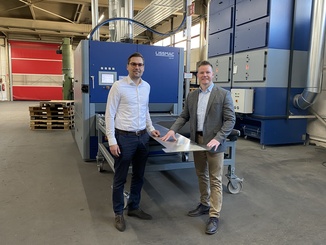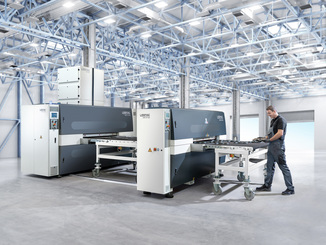
Euroblech is one of the most important trade fairs for the machine builder Lissmac with a focus on sheet metal working. This year, the company will focus on presenting the SBM and SMD-3 series. Both types of equipment can be customized to meet a wide range of customer requirements.
Basically, Lissmac customers always have the option of choosing between two machine concepts with regard to their job processing: double-sided processing in one operation or single-sided processing – dry on one side or wet on the other.

© Lissmac
Lots of efficiency potential: dry machining on both sides
In Hanover, Lissmac will present three models of the SBM series. “These machines set standards in sheet metal processing. In the dry machining process, the efficient double-sided machining of all cutting contours on sheet metal, i.e. the outer and inner contours, takes place in just one work process. Synchronous machining on both sides offers maximum productivity and the best machining results,” says the manufacturer.
The machining principle ensures uniform tool wear across the entire working width. Moreover, dry processing means that no chemical additives are required, as is the case with vibratory grinding. According to Lissmac, all systems in this series stand for energy efficiency and consistently high processing quality. In addition, a quick and easy tool change is possible.
The Lissmac equipment portfolio comprises four machine series. Depending on the production task or sheet thickness, the SBM-XS, SBM-M, SBM-L or SBM-XL series is appropriate. These machine models differ in terms of working width and the number and type of aggregates for workpiece machining
Fully automatic small parts processing
Particularly in small parts machining, high quantities are often processed. Lissmac presents its SBM-XS 300 Alu Mix small parts deburring machine with a loading robot. The system ensures a low-staff and efficient production process through bin picking. It also features a modern, compact machine design and thus a small footprint, as well as simple and intuitive machine operation. The SBM-XS 300 Alu Mix with vacuum table is designed for deburring and edge rounding of steel, stainless steel and aluminum with sheet thicknesses from 1 to 15 mm and – depending on the geometry – for part sizes from 45 x 45 x 1 mm to a maximum of 200 x 200 x 15 mm. Inner and outer contours are processed equally. The integrated turning station eliminates the need for time-consuming turning and reprocessing of parts. Folding away the turning station allows parts with an edge length of more than 200 mm to be processed on one side.
For simultaneous deburring and edge rounding of the inner and outer contours of stamped parts, as well as for laser- or fine plasma-cut workpieces, the two dry-operating SBM-L 1000 G1S2 and SBM-L 1500 G1S2 systems will be on display. The focus of the two systems, which are implemented with passage widths of 1000 mm and 1500 mm respectively, is the removal of spatter on the sheet surface. Here, too, the deburring of the often very heavy workpieces on both sides saves cost-intensive turning and machining of the parts twice. The processing units are individually electrically adjustable and can be switched on and off. The cross-machining principle ensures optimum tool utilization across the entire working width, and the modular, compact construction in modern machine design requires only a small footprint.
Very important for the employees at the plant is the improved working environment of the plant through extraction and filter technology. This significantly reduces dust, dirt and noise pollution. Optional smart features include automatic tool wear compensation, automatic sheet thickness measurement, a barcode scanner and other tools.

© Lissmac
Single-sided, efficient dry machining for beginners and professionals
The product range of single-sided dry grinding machines includes, on the one hand, the particularly economical entry-level models of the SMD-1 series. Their application spectrum ranges from deburring and all-round edge rounding to the removal of heavy plasma or flame-cut slag.
At Euroblech, Lissmac will present the universal entry-level machine SMD 123 RE, which can be used for machining steel, stainless steel and aluminum. It is suitable for removing cutting burrs that occur during punching or laser and plasma cutting. The system’s two rotor heads enable uniform edge rounding on all sides and also a directionless finish. The creation of a surface grind is possible without extensive setup work. Likewise, components can be machined with forming operations. The SMD 123 RE has a small footprint and can be operated intuitively via a touch panel. Other features include separate switching on and off of the processing units, a continuously adjustable sanding belt speed, and a quick and easy tool change.
In the high-performance segment, the versatile models of the SMD 3 series are convincing for efficient part processing from 50 x 50 mm regardless of the part geometry. The application spectrum ranges from slag removal, deburring and uniform edge rounding up to radius 2.0 mm to surface finishing and small parts machining. “The sophisticated tool arrangement of the SMD3 series ensures a uniform machining result over the entire working width. Maximum tool contact with the components ensures perfect edge rounding up to a radius of 2 mm.
A program memory ensures automatic machine setting and reproducible machining results, and a fixed machine table with constant table height ensures ergonomic working,” says machine manufacturer Lissmac, summarizing some of the advantages. Added to this is intuitive operation thanks to a clear touch panel and fast machine setting thanks to automatic positioning of the mold axes. A quick mold change system reduces setup times to a minimum and optimum accessibility to the machine facilitates cleaning and maintenance.
In Hanover, trade show visitors can also find out more about the SMD 345 REER (S-Edition). The system can be used for a wide range of applications – from edge rounding R2 to finishing. Multiple round brushes also enable the creation of directionless grinding patterns and strong edge rounding. According to Lissmac, the machine is also predestined for the processing of sheets with coating, foiling, embossing or pull-throughs, the processing of different materials such as steel, stainless steel and aluminum, and the simultaneous processing of different material thicknesses.
The SMD 335 DRE (P-Edition), which will also be presented, is suitable for machining thick sheets. It scores with cool-grinding due to low heat input into the workpieces. Mechanical slag removal also eliminates the need for expensive machining, and the result is reduced tooling costs for users. As with all systems in the SMD 3-series, Lissmac also offers various optional features for individual customer requirements.
In cooperation with the straightening technology specialists from Kohler Maschinenbau GmbH, Lissmac will also be presenting a processing line for deburring and part straightening in a single operation at its booth. The linking of the two processes ensures an efficient manufacturing process and material flow and thus significantly reduces the effort required for material handling and logistics. “Highest machining quality of the workpieces is the optimum prerequisite for further machining and processing of the components,” says Lissmac.
Annedore Bose-Munde, specialist journalist from Erfurt
Euroblech Hall 14, Booth K06
Web:
www.lissmac.com



